
Torres Vedras is a municipality in the Portuguese district of Lisbon, approximately 40 kilometres (25 mi) north of the capital Lisbon in the Oeste region, in the Centro of Portugal. The population as of 2011 was 83,075, in an area of 407.15 square kilometres (157.20 sq mi).
The Castro of Vila Nova de São Pedro is a Chalcolithic archaeological site in the civil parish of Vila Nova de São Pedro, municipality of Azambuja, in the Portuguese Estremadura area of Lezíria do Tejo. It is important for the discovery of thousands of arrowheads within its fortified settlement, associated with the Chalcolithic period of human settlement. associated with the long-lived fortified town, or castro, of Zambujal, near the municipality of Torres Vedras. The period of "urban" settlement lasted from 2600 to 1300 BCE, and was a contemporary of the southeastern Spanish settlements of Los Millares and El Argar.
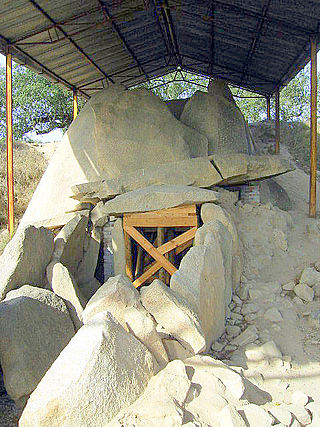
Great Dolmen of Zambujeiro is a megalithic monument located in Nossa Senhora da Tourega, near Valverde, in the municipality of Évora, considered one of the biggest such structures in the Iberian Peninsula.

The Prehistoric Rock-Art Site of Escoural Cave is a structure known for its Paleolithic-era rock-art and funerary burial site, located in the Portuguese municipality of Montemor-o-Novo, in the civil parish of Santiago do Escoural.
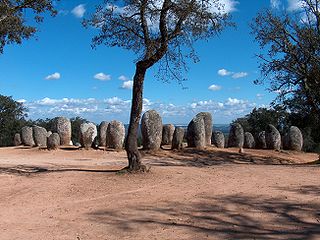
The Cromlech of the Almendres is a megalithic complex, located 4.5 road km WSW of the village of Nossa Senhora de Guadalupe, in the civil parish of Nossa Senhora da Tourega e Nossa Senhora de Guadalupe, municipality of Évora, in the Portuguese Alentejo. The largest existing group of structured menhirs in the Iberian Peninsula, this archaeological site consists of several megalithic structures: cromlechs and menhir stones, that belong to the so-called "megalithic universe of Évora", with clear parallels to other cromlechs in Évora District, such as Portela Mogos and the Vale Maria do Meio Cromlech.

The Castro of Zambujal is a Chalcolithic age archeological site in the civil parish of Santa Maria, São Pedro e Matacães, municipality of Torres Vedras in the western litoral area of the Portuguese Centro Region. The Zambujal Castro is one of the most important Copper Age settlements in the peninsula of Lisbon, and whose culture lasted until the beginning of the agrarian periods of Iberian history. Apart from being the most northerly discovered Copper Age site in Portugal, it went through two main building phases: an import-oriented phase and the second associated with the Beaker culture.

The Megalithic Monuments of Alcalar are a group of burial tombs that comprise a Calcolithic necropolis, located in the civil parish of Mexilhoeira Grande, municipality of Portimão, Portugal.

The Anta do Monte Abraão was a megalithic dolmen located in the parish of Monte Abraão, in Queluz, Sintra Municipality, Lisbon District, Portugal. The dolmen was first identified in 1876, by Carlos Ribeiro, who carried out excavations until 1878 and published his results in 1880. Excavations suggest that it served as a tomb for about 80 individuals and that it dates back to the middle to end of the Neolithic period. The Anta do Monte Abraão and the nearby Anta da Pedra dos Mouros and Anta da Estria are collectively known as the Antas de Belas.
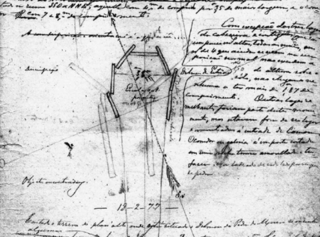
The Anta da Estria is a megalithic dolmen situated between Belas and Queluz in the Lisbon District of Portugal. Based on datings of human remains, it is believed to date back to the late-Neolithic and early-Chalcolithic eras. The Anta da Estria, the Anta do Monte Abraão and the Anta da Pedra dos Mouros are collectively known as the Antas de Belas, and were first identified in the 1870s by Carlos Ribeiro (1813-1882), who is regarded as the "father" of Portuguese prehistoric archaeology.

The Anta da Pedra dos Mouros, also known as the Anta do Senhor da Serra, is a megalithic dolmen situated near Belas and Queluz in the Lisbon District of Portugal. It is believed to date back to the late-Neolithic and early-Chalcolithic eras. The Anta da Pedra dos Mouros, the Anta da Estria, and the Anta do Monte Abraão are a short distance from each other and are collectively known as the Antas de Belas. The Anta da Pedra dos Mouros was first identified in the 1850s by Carlos Ribeiro. Despite being registered and protected as a national monument in 1910, the dolmen has recently suffered significant damage.

The Leonel Trindade Municipal Museum is an archaeological and historical museum in the town and municipality of Torres Vedras, Lisbon District, Portugal. It is located in a former convent on the southern edge of the city centre. In addition to an extensive archaeological section dating back to late- Palaeolithic times, the museum contains works of art from local churches as well as an exhibition relating to the Lines of Torres Vedras, defensive lines constructed under the orders of the British Duke of Wellington to defend against French invasion during the Peninsular war.
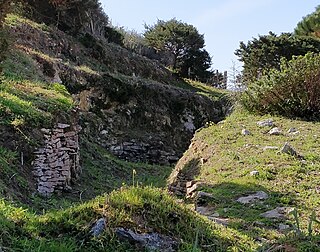
The Praia das Maçãs Prehistoric Monument, also known as the Tholos of Outeiro das Mós, consists of an artificial Neolithic cave and a Chalcolithic domed or beehive tomb. It is situated close to the Praia das Maçãs beach, near the town of Colares in Sintra municipality, in the Lisbon District of Portugal. The area was discovered in 1927. As an important prehistoric sepulchral site, it was classified as a national monument in 1974. Surrounded by housing, the location has been designated as a special zone of protection, and construction is forbidden. Plans by Sintra and the Directorate-General for Cultural Heritage to turn the complex into a museum area, first discussed in 2001, have not yet been implemented. For purposes of protection the site has been covered by sand and there is little presently visible.

The Anta de Carcavelos, located close to the village of Carcavelos near the town of Lousa in the municipality of Loures in the Lisbon District of Portugal, is a stone age dolmen or megalithic monument from the Chalcolithic period. It is one of many such tombs that have been identified in Portugal.

The Anta do Alto da Toupeira, also called the Anta da Toupeira or the Anta de Salemas, is a Neolithic dolmen, or megalithic tomb, situated in the parish of Lousa in the municipality of Loures, in the Lisbon District of Portugal. It dates back to the Chalcolithic.

The four Artificial caves of Casal do Pardo, also known as the Caves of Quinta do Anjo, were neolithic tombs. They are situated in Palmela municipality in the Setúbal District, of Portugal, about 25 km (16 mi) south of the capital of Lisbon. These caves were classified as a National Monument of Portugal in 1934.

The Necropolis of Carenque is an archaeological site consisting of three well-preserved late Neolithic collective sepulchres or tombs, dating back to about 3000 BCE, which are dug into smooth limestone outcrops. It is situated in the municipality of Amadora in the Lisbon District of Portugal.
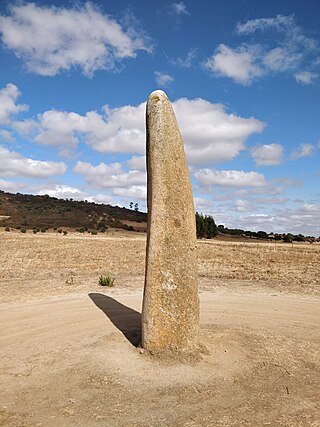
The Menhir of Outeiro, also known as the Penedo Comprido is a megalith located midway between the villages of Outeiro and Barrada near the municipality of Reguengos de Monsaraz, in the district of Évora, in the Alentejo region of Portugal. It is a few kilometers from the Portuguese-Spanish-border. The stone was discovered on its side in 1969 by Henrique Leonor Pina and José Pires Gonçalves and, on the initiative of Gonçalves, it was raised again around 1970. The menhir was classified as a Portuguese National Monument in 1971.

The Antas do Olival da Pêga are located near the village of Telheiro, in the municipality of Reguengos de Monsaraz, in the Évora district of the Alentejo region of Portugal. Anta is the Portuguese name for a dolmen, a single-chamber megalithic tomb. These two neolithic dolmens were used over a long period, from the late neolithic to the chalcolithic. The tombs were originally identified by the German archaeologists, Georg and Vera Leisner, who excavated Anta 1, with Anta 2 being subsequently excavated from the 1990s by Victor Gonçalves and Ana Catarina Sousa of the Centre of Archaeology of the University of Lisbon (UNIARQ). In addition to the visible stones at the two sites, which are about 300 meters apart, many items have been found as a result of excavations. Over one hundred people were buried in each tomb. The proximity of the two tombs gives rise to the conclusion that both were part of the same megalithic complex.

The Anta da Vidigueira is a megalithic dolmen or burial chamber located southwest of the village of Freixo, in Redondo municipality in the Évora district of the Alentejo region of Portugal. The dolmen was probably constructed between the Neolithic and the Chalcolithic. It has been classified as a National Monument since 1910.


















